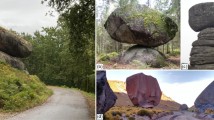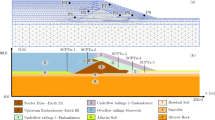Abstract
Rock slopes undergoing long–term effects of weathering and gravity may gradually deform or creep downslope leading to geological structures such as bending, bucking, fracturing, or even progressive failure. This study uses geomechanics-based numerical modeling to qualitatively explain the cause and evolution of slope creep behavior. Constitutive models used include the creep, Mohr–Coulomb, and anisotropic models. The last two models are used with the strength reduction in calculation. First, the results of field investigation around a landslide site occurring in slate are present. The causes and modes of creep structures observed on slopes and underground are studied. Second, the study investigates the influences of slope topography and anisotropy orientations on slope creep behavior. Finally, progressive failure of slopes with different shapes is examined. The simulated results show that the bending type of structures develops near slope surfaces, and the buckling type of structures is associated with the deformation or slides of a slope. The creep pattern varies with the orientation and position of an original planar structure. The shear zone involves a joint or fracture along which displacement has taken place. Moreover, creep behavior is more significant on slopes with greater height and inclination as well as on steeper portions whether on concave or convex slopes. In addition, with the same topographic conditions, consequent slopes with coinciding cleavage and obsequent slopes with steep cleavage result in greater creep behavior. Without the effects of anisotropic cleavage, concave and straight slopes develop failure surfaces from the crowns downwards, whereas convex slopes develop failure surfaces from the toes upwards.
















Similar content being viewed by others
References
Amadei B (1996) Importance of anisotropy when estimating and measuring in situ stresses in rock. Int J Rock Mech Min Sci Geomech Abstr 33(3):293–325
Aydan Ö, Akagi T, Kawamoto T (1996) The squeezing potential of rock around tunnels: theory and prediction with examples taken from Japan. Rock Mech Rock Eng 29:125–143
Bovis MJ, Evans SG (1996) Extensive deformations of rock slopes in southern Coast Mountains, southwest British Columbia, Canada. Eng Geol 44:163–182
Brideau M, Stead D (2012) Evaluating kinematic controls on planar translational slope failure mechanisms using three-dimensional distinct element modeling. Geotech Geol Eng 30:991–1011
Brinkgreve RBJ, Broere W, Waterman D (2008) PLAXIS, finite element code for soil and rock analyses, 2D-version 9
Cai M, Kaiser PK, Tasaka Y, Minami M (2007) Determination of residual strength parameters of jointed rock masses using the GSI system. Int J Rock Mech Min Sci 44:247–265
Chang KT, Wan S, Lei TC (2010) Development of a spatial decision support system for monitoring earthquake-induced landslides based on aerial photographs and the finite element method. Int J Appl Earth Obs Geoinf 12(6):448–456
Chigira M (1992) Long-term gravitational deformation of rocks by mass rock creep. Eng Geol 32:157–184
Desai CS, Samtani NC, Vulliet L (1995) Constitutive modeling and analysis of creeping slopes. J Geotech Eng 121:43–56
Dubey RK, Gairola VK (2008) Influence of structural anisotropy on creep of rock salt from Simla Himalaya, India: an experimental approach. J Struct Geol 30:710–718
Eberhardt E, Thuro K, Luginbuehl M (2005) Slope instability mechanisms in dipping interbedded conglomerates and weathered marls—the 1999 Rufi landslide, Switzerland. Eng Geol 77:35–56
El Bedoui S, Guglielmi Y, Lebourg T, Pérez J (2009) Deep-seated failure propagation in a fractured rock slope over 10,000 years: the La Clapière slope, the south-eastern French Alps. Geomorphology 105:232–238
Fabre G, Pellet F (2006) Creep and time-dependent damage in argillaceous rocks. Int J Rock Mech Min Sci 43:950–960
Fakhimi AA, Fairhurst C (1994) A model for the time-dependent behavior of rock. Int J Rock Mech Min Sci 31:117–126
Federico A, Popescu M, Elia G, Fidelibus C, Interno` G, Murianni A (2012) Prediction of time to slope failure: a general framework. Environ Earth Sci 66:245–256
Fernández-Merodo JA, García-Davalillo JC, Herrera G, Mira P, Pastor M (2012) 2D viscoplastic finite element modelling of slow landslides: the Portalet case study (Spain). Landslides. doi:10.1007/s10346-012-0370-4
Fischer L, Amann F, Moore JR, Huggel C (2010) Assessment of periglacial slope stability for the 1988 Tschierva rock avalanche. Eng Geol 116:32–43
Goodman RE (1989) Introduction to rock mechanics. Wiley
Goodman RE (1993) Engineering geology. Wiley
Grøneng G, Lu M, Nilsen B, Jenssen AK (2010) Modelling of time-dependent behavior of the basal sliding surface of the Åknes rockslide area in western Norway. Eng Geol 114:414–422
Hoek E, Carranza-Torres C, Corkum B (2002) Hoek–Brown failure criterion—2002 edn. In: Proceedings of NARMS-TAC Conference, vol 1. Toronto, pp 267–273
Jarman D (2006) Large rock slope failures in the Highlands of Scotland: characterization, causes and spatial distribution. Eng Geol 83:161–182
Malan DF (1999) Time-dependent behaviour of deep level tabular excavations in hard rock. Rock Mech Rock Eng 32:123–155
Margielewski W (2006) Structural control and types of movements of rock mass in anisotropic rocks: case studies in the Polish Flysch Carpathians. Geomorphology 77:47–68
Martin Y (2000) Modelling hillslope evolution: linear and nonlinear transport relations. Geomorphology 34:1–21
Mitchell JK, Soga K (2005) Fundamentals of soil behavior. Wiley
Mufundirwa A, Fujii Y, Kodama J (2010) A new practical method for prediction of geomechanical failure-time. Int J Rock Mech Min Sci 47:1079–1090
Pellegrino A, Prestininzi A (2007) Impact of weathering on the geomechanical properties of rocks along thermal—metamorphic contact belts and morpho-evolutionary processes: the deep-seated gravitational slope deformations of Mt. Granieri-Salincriti (Calabria–Italy). Geomorphology 87:176–195
Petley DN, Higuchi T, Petley DJ, Bulmer MH, Carey J (2005) Development of progressive landslide failure in cohesive materials. Geology 33:201–204
Qi S, Xu Q, Lan H, Zhang B, Liu J (2010) Spatial distribution analysis of landslides triggered by 2008.5.12 Wenchuan earthquake, China. Eng Geol 116:95–108
Rocscience Inc (2013) RocLab, rock mass strength analysis using the generalized Hoek–Brown failure criterion. version 1
Shao JF, Zhu QZ, Su K (2003) Modeling of creep in rock materials in terms of material degradation. Comput Geotech 30:549–555
Shin K, Okubo S, Fukui K, Hashiba K (2005) Variation in strength and creep life of six Japanese rocks. Int J Rock Mech Min Sci 42:251–260
Soil and Water Conservation Bureau of Taiwan (2006) Remediation and investigation of the landslide from 88 K to 91 K of the route 14. Report No. SWCB-95-074
Turner AK, Schuster RL (1996) Landslides: investigation and mitigation, Transportation Research Board, National Research Council
Varnes DJ (1978) Slope movement types and processes. Landslides, analysis and control. Transp Res Board Spec Rep 176:11–33
Wangensteen B, Guðmundsson Á, Eiken T, Kääb A, Farbrot H, Etzelmüller B (2006) Surface displacements and surface age estimates for creeping slope landforms in Northern and Eastern Iceland using digital photogrammetry. Geomorphology 80:59–79
Willenberg H, Evans KF, Eberhardt E, Spillmann T, Loew S (2008) Internal structure and deformation of an unstable crystalline rock mass above Randa (Switzerland): part II—three-dimensional deformation patterns. Eng Geol 101:15–32
Zienkiewicz OC, Taylor RL (2000) The finite element method, 5th edn. Oxford
Acknowledgments
Support for this research by the National Science Council, Taiwan through the Grant NSC 99-2625-M-005-006-MY3 is gratefully acknowledged.
Author information
Authors and Affiliations
Corresponding author
Rights and permissions
About this article
Cite this article
Chang, KT., Ge, L. & Lin, HH. Slope creep behavior: observations and simulations. Environ Earth Sci 73, 275–287 (2015). https://doi.org/10.1007/s12665-014-3423-2
Received:
Accepted:
Published:
Issue Date:
DOI: https://doi.org/10.1007/s12665-014-3423-2




